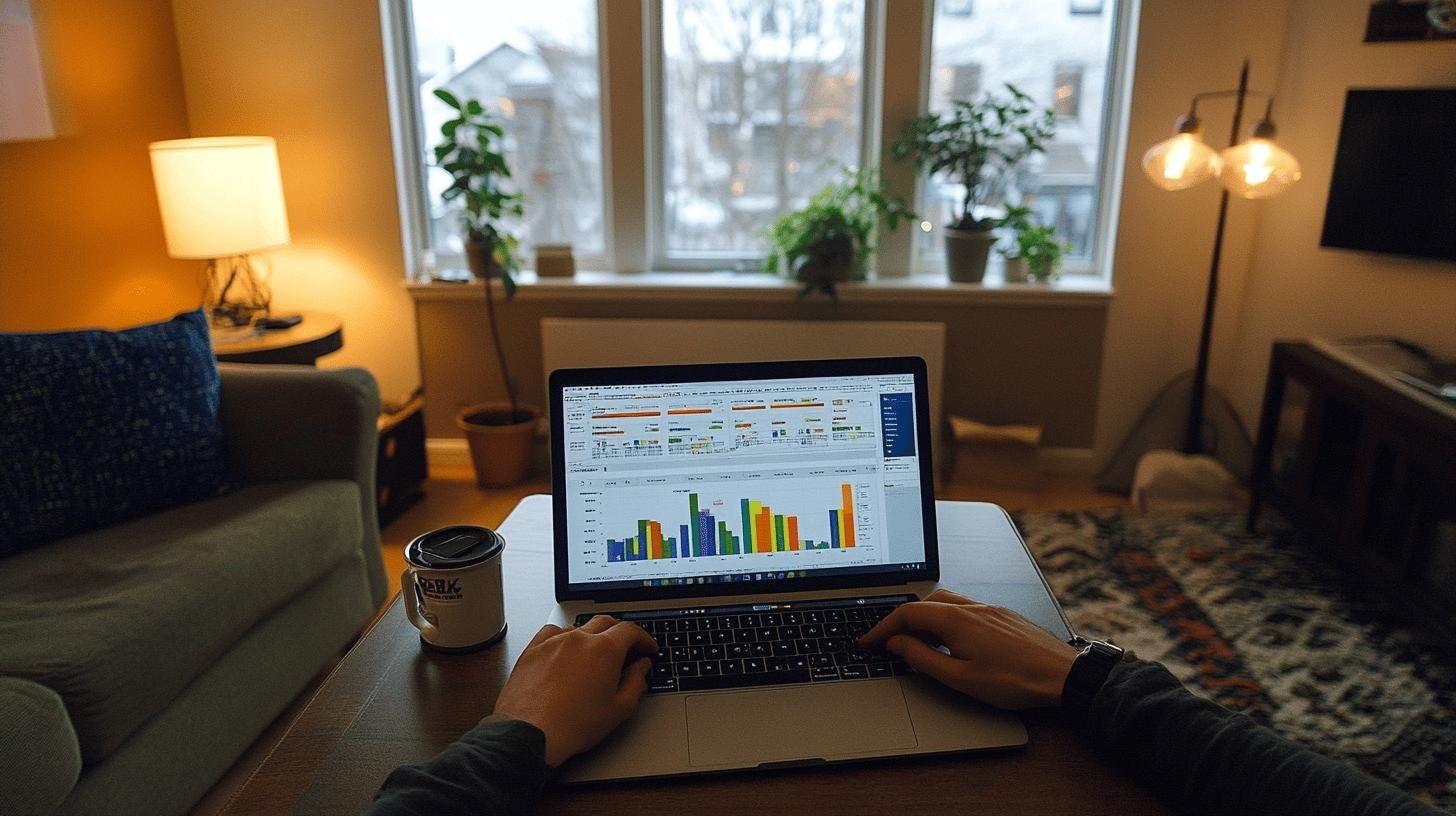Ever feel like you’re drowning in data but not sure how to use it? 💡 Imagine turning all that info into clear, actionable insights that drive your business forward. Data Analytics and Business Intelligence (BI) do just that. They transform raw data into powerful information for smarter decisions.
Ready to see how this dynamic duo can revolutionize your business strategy? Let’s dive into the world of Data Analytics BI and discover how it’s changing the game! 🚀
Understanding Data Analytics and BI
Business Intelligence (BI) focuses on using data to make smart decisions. It involves technologies, practices, and software that help collect, sort, analyze, and present data. Think of BI as a tool that looks at past events to make better choices for the future.
Data Analytics, on the other hand, examines raw data to find patterns, trends, and insights. It uses machine learning and automation to dig deep into data sets. Unlike BI, data analytics focuses on predicting future trends and outcomes using statistical and mathematical methods.
Key Differences Between BI and Data Analytics
- Focus: BI looks at past data, while data analytics predicts future trends.
- Data Used: BI uses historical data; data analytics works with both historical and real-time data.
- Techniques: BI involves data visualization tools like dashboards; data analytics uses statistical models and algorithms.
- Purpose: BI informs decision-making; data analytics uncovers deeper insights.
- Users: BI is often used by non-technical users, while data analytics typically requires more technical skills.
Despite their differences, BI and data analytics work hand in hand. BI provides a clear picture of what has happened, and data analytics predicts what might happen next. Together, they offer a comprehensive view that helps businesses make informed decisions and stay ahead of the game.
Popular Tools for Data Analytics and BI

Power BI is a top player in the BI and data analytics world. It offers powerful data visualization, real-time analytics, and seamless integration with various data sources. Power BI makes it easy to create interactive dashboards that help businesses make informed decisions quickly. Plus, it’s user-friendly, so even novices can use it without frustration.
Tableau is another big name in the game. Known for creating interactive, shareable dashboards that are engaging, Tableau excels at data blending, allowing users to combine data from multiple sources effortlessly. Its drag-and-drop interface is a hit, making it simple for users to dig into data and uncover insights without needing a technical background.
Here are four other popular BI tools:
- Google Analytics: Tracks and analyzes website traffic.
- QlikView: Offers powerful data visualization and analytics.
- Microsoft Excel: A classic tool for data analysis and reporting.
- IBM Cognos: Provides comprehensive BI solutions for large enterprises.
| Feature | Power BI | Tableau |
|---|---|---|
| Data Visualization | Robust | Excellent |
| Integration | Seamless with various sources | Strong data blending |
| User Interface | User-friendly | Drag-and-drop |
| Real-time Analytics | Yes | No |
Methodologies in Data Analytics and BI
ETL (Extract, Transform, Load) processes are the backbone of BI. First, data is extracted from various sources like databases and cloud services. Then, it’s transformed into a consistent format, making it easier to analyze. Finally, the cleaned data is loaded into a data warehouse or database, ready for analysis. ETL ensures that the data you work with is accurate, reliable, and useful for making decisions.
Predictive Analytics is about looking into the future. By analyzing historical data, it predicts what might happen next. It’s crucial because it helps businesses prepare for future trends and events. For example, retailers can use predictive analytics to forecast inventory needs, reducing waste and maximizing profits. It employs methods like decision trees and neural networks, which are smart algorithms that learn from past data to make predictions.
Six Predictive Analytics Techniques
- Decision Trees: Break down data into smaller parts to make predictions.
- Neural Networks: Mimic the human brain to find patterns and trends.
- Regression Analysis: Understand relationships between different variables.
- Time Series Analysis: Analyze data points over time to forecast future trends.
- Clustering: Group similar data points together to find patterns.
- Association Rule Learning: Discover interesting relationships between variables in large databases.
Data Modeling in BI is like building a blueprint for your data. It involves structuring data in a way that makes it easy to query and analyze. Think of it as organizing your data into tables and relationships that make sense. This helps businesses quickly find the information they need and make informed decisions. Data modeling is essential for efficient data management and real-time intelligence, making it a cornerstone of effective BI practices.
Case Studies: Success Stories in Data Analytics and BI

In healthcare, the FDA has leveraged data analytics to enhance responses to food-related illnesses. By analyzing data in real-time, they can quickly identify patterns in food-borne diseases. This allows them to take swift action, reducing the spread of illnesses and potentially saving lives. The use of BI tools ensures that crucial data is continuously monitored, helping healthcare professionals make prompt, informed decisions.
In the supply chain sector, companies have turned to Power BI to streamline operations. For instance, a major retailer used Power BI to analyze its supply chain data. The tool helped identify bottlenecks and inefficiencies, allowing them to optimize logistics and reduce costs. With real-time insights, they could make immediate adjustments, ensuring smoother operations and better inventory management.
Marketing departments also benefit significantly from data analytics. A global brand used Power BI to track the effectiveness of their marketing campaigns. By examining data on customer engagement and sales, they could pinpoint which strategies were working and which weren’t. This real-time feedback loop enabled them to tweak their campaigns on the fly, maximizing ROI and improving customer targeting.
Five Industries Benefiting from BI and Data Analytics
- Healthcare: Enhanced patient care and disease response.
- Retail: Optimized supply chain and inventory management.
- Finance: Improved risk management and fraud detection.
- Manufacturing: Streamlined production processes.
- Marketing: Better campaign tracking and customer insights.
Trends and Future Directions in Data Analytics and BI
The importance of BI and data analytics in business decision-making is skyrocketing. Accurate, data-driven decisions help reduce mistakes and save resources. With the data analytics industry projected to reach over $250 billion in revenues by 2022, companies are keen on leveraging these tools.
Businesses use BI to analyze past performance and make informed choices that shape future strategies. This trend highlights how essential BI and data analytics have become for maintaining a competitive edge.
Advancements in machine learning and AI are revolutionizing how businesses use BI. These technologies drive the adoption of advanced analytics, making it easier to predict future trends. For instance, predictive modeling in BI uses historical data to forecast outcomes, allowing companies to be proactive rather than reactive. This shift means businesses can anticipate customer needs, optimize operations, and improve overall efficiency. The integration of machine learning and AI into BI tools is making them smarter and more effective.
Four Emerging Trends in BI and Data Analytics
- Augmented Analytics: Using AI to automate data insights.
- Data Governance: Ensuring data quality and compliance.
- Natural Language Processing: Making data queries as simple as asking questions.
- Edge Computing: Processing data closer to its source for real-time insights.
The Rise of Cloud-Based BI Tools
Cloud-based BI tools are becoming increasingly popular due to their scalability and accessibility. These tools allow businesses to store and analyze vast amounts of data without the need for expensive on-site infrastructure. They offer the flexibility to scale resources up or down based on demand, making them ideal for businesses of all sizes.
Plus, cloud-based BI tools are accessible from anywhere, providing real-time insights to decision-makers, no matter where they are. This trend is driving more businesses to adopt cloud solutions for their BI needs.
Final Words
From understanding the key differences between business intelligence (BI) and data analytics to exploring popular tools like Power BI and Tableau, we’ve covered a lot. We dove into essential methodologies, showed real-life success stories, and peeked into future trends. It’s clear data analytics and BI are game-changers for decision-making.
Don’t be afraid to geek out on these tools and techniques—they’re reshaping how we make sense of data. The world of Data Analytics BI is here to stay, so let’s harness its power and make smarter choices together. 🚀 Explore more on Wikiwayne!
FAQ
What is BI data analytics?
BI data analytics involves using data and analytics methods to make better business decisions. This can include technologies and practices that enhance data collection, sorting, analysis, and presentation.
What is the difference between a BI and a data analyst?
A BI analyst focuses on using past data to inform future decisions, creating dashboards and reports. A data analyst, meanwhile, primarily analyzes raw data to uncover patterns and predict future trends.
What is data analytics with Power BI?
Data analytics with Power BI involves using this tool to visualize data, create interactive dashboards, and generate real-time insights that help in better decision-making.
What does a BI-analyst do?
A BI-analyst collects, processes, and analyzes data to create reports that inform business strategy. They use tools like Power BI and Tableau to present data visually and help organizations make data-driven decisions.
What is the difference between Business Intelligence and Data Analytics?
Business intelligence focuses on using historical data to guide future decisions with dashboards and reports. Data analytics examines raw data to uncover insights and predict future trends using statistical methods and machine learning.




